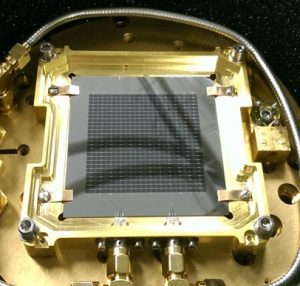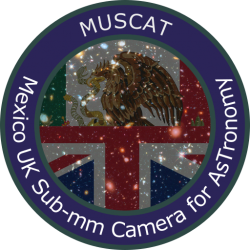Detector Technology

The Lumped-Element Kinetic Inductance Detector (LEKID), invented and developed at Cardiff University’s Astronomical Instrumentation Group (AIG), is one of the underpinning technologies of MUSCAT. This new detector technology measures the change in phase (ΔΦ) of a superconducting circuit that varies upon absorption of mm-wave radiation. This elegant solution allows the multiplexing of around 1,000 pixels onto a pair of coaxial cables removing all complex readout components from cryogenic temperatures to room temperature. As well as being simple to multiplex the LEKID is also incredibly simple to fabricate with typical arrays consisting of a single deposition and etch step.

The fundamental noise limit of a LEKID is dictated by the random generation and recombination of paired electrons in the meander section. For MUSCAT, this limit is roughly two of orders of magnitude lower than that imposed by the background photon noise typical of observing conditions at the LMT site. Furthermore, the required performance has been demonstrated in such detectors in both laboratory tests and large-format arrays on the NIKA instrument hosted by the IRAM 30-m telescope. The MUSCAT focal plane consists of over 1,500 LEKIDs and the optics have been designed such to maximise the use of the 50-m LMT.
Cryostat
The MUSCAT detectors are housed inside a specially developed cryogenic platform which also houses cooled optical components. To maximise the sensitivity of the LEKIDs, the detectors are cooled to a temperature of 100 mK (-273.05°C) through a series of cooling systems. This approach also produces a versatile platform that can be expanded and adapted to ensure long-term return on this investment.
The first cooling stage of MUSCAT is a 2.0-W pulse-tube cooler from Cryomech which provides cooling down to 4 K (-269.15°C). MUSCAT then utilises a unique combination of continuous sorption coolers and a miniature dilution refrigerator developed by Chase Cryogenics in collaboration with Cardiff University’s AIG.
Optics and Filtering
MUSCAT optically interfaces with the LMT through a series of mirrors and horn receivers all of which are designed to maximise the field of view provided by the LMT’s 50-m primary mirror. MUSCAT’s optical band is defined using Cardiff University’s world-leading metal-mesh filter technology. The UK portion of the team has designed, built and optimised filters for optimal in-band selection and rejection of out-of-band radiation from the instrument, the telescope and the sky.
Detector Readout
MUSCAT uses specially-developed, state-of-the-art readout based upon the ROACH2 Field Programmable Gate Array (FPGA) card.

